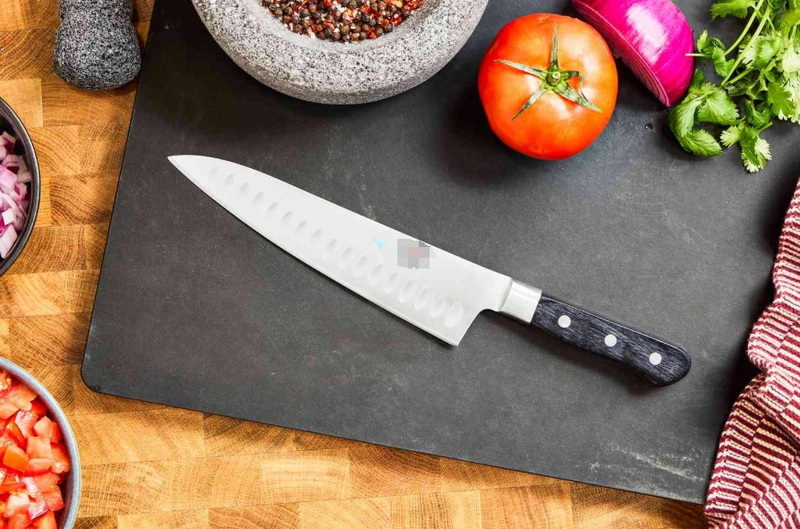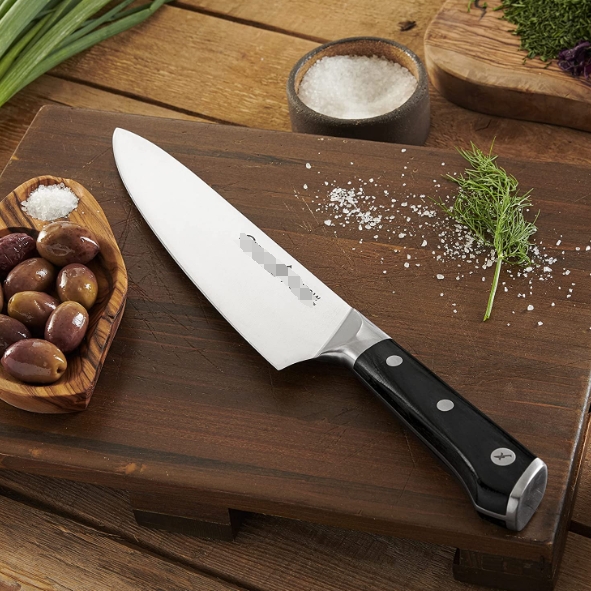

Views: 222 Author: Ella Publish Time: 2025-05-02 Origin: Site








Content Menu
● Why a Good Chef Knife Matters for Beginners
● Understanding Chef Knife Basics
● Key Features to Look for in a Beginner Chef Knife
>> Blade Material and Sharpness
>> Blade Length
>> Handle Comfort and Material
● Popular Types of Chef Knives for Beginners
● How to Choose the Right Chef Knife: Step-by-Step
>> 1. Consider Your Cooking Style and Needs
>> 3. Decide on Blade Material and Maintenance
>> 5. Look for Quality Construction
● Essential Knife Skills for Beginners
>> Proper Grip
>> Safety Tips
● Recommended Chef Knives for Beginners
● Advanced Tips and Techniques
>> Understanding Blade Geometry
>> Sharpening with a Whetstone
>> Advanced Cutting Techniques
● FAQ
>> 1. What size chef knife is best for beginners?
>> 2. Should beginners choose a Japanese or German style chef knife?
>> 3. How do I know if a chef knife is comfortable?
>> 4. How often should I sharpen my chef knife?
>> 5. Can I use one chef knife for all kitchen tasks?
Choosing the right chef knife is a foundational step for anyone starting their culinary journey. A good chef knife not only enhances your efficiency and precision in the kitchen but also ensures safety and comfort while preparing meals. This comprehensive guide will walk you through everything you need to know to select the perfect chef knife for beginners, covering types, materials, sizes, handling techniques, maintenance, and more.

A chef knife is the most versatile and frequently used tool in the kitchen. For beginners, having a knife that feels comfortable, balanced, and sharp can transform cooking from a daunting task into a pleasurable experience. The right knife helps you:
- Cut ingredients more precisely and efficiently
- Reduce the risk of accidents caused by slipping or dull blades
- Build confidence in your knife skills and cooking techniques
When your knife feels like an extension of your hand, you naturally develop smoother, safer cutting techniques, making cooking more enjoyable and less frustrating.
Before diving into how to choose a chef knife, it's important to understand its essential components:
- Blade: The cutting surface, which varies in shape and size depending on the knife type.
- Edge: The sharpened side of the blade, which can be straight or serrated.
- Handle: The grip area, crucial for comfort and control.
- Tang: The part of the blade that extends into the handle; a full tang (running the full length) offers better balance and durability.
- High-Carbon Stainless Steel: Ideal for beginners because it combines sharpness with rust resistance and easier maintenance. This steel resists stains and corrosion better than traditional carbon steel while holding a sharp edge well.
- Japanese Steel: Typically harder and sharper, but more prone to chipping and requires careful maintenance.
- German Steel: Softer and more durable, forgiving for heavy-duty tasks and easier to maintain, making it practical for novices.
- The most popular and versatile blade length for beginners is 8 inches. It offers a good balance between control and efficiency for a wide range of kitchen tasks without being too bulky or unwieldy.
- Smaller blades (6-7 inches) suit those with smaller hands or who prefer more precision, while larger blades (10-12 inches) are better for bigger hands or heavy-duty chopping but can be harder to control.
- The handle should feel comfortable and secure in your hand, with no awkward pressure points.
- Materials vary from wood, plastic, composite, to rubberized grips. Beginners often benefit from ergonomic, slip-resistant handles that provide good grip even when wet.
- Try holding the knife before purchasing to ensure it fits your hand size and grip style.
- A well-balanced knife feels like an extension of your hand, neither too heavy nor too light.
- Forged knives (made from a single piece of steel) tend to be heavier and better balanced than stamped knives (cut from sheet metal), but personal preference plays a big role.
| Knife Type | Description | Best For |
|---|---|---|
| Gyuto (Japanese Chef Knife) | Multi-purpose with a thinner, sharper blade | Versatile for meat, fish, vegetables |
| Santoku | Japanese-style, shorter blade with a flat edge | Slicing, dicing, mincing vegetables |
| Western (German) Chef Knife | Heavier, thicker blade, very durable | Heavy-duty chopping and general use |
| Nakiri | Straight-edged Japanese knife | Precision vegetable cutting |
| Bunka | Japanese multipurpose knife with a pointed tip | Versatile, especially for vegetables |
| Utility Knife | Smaller than a chef's knife, but larger than a paring knife | Smaller tasks, trimming vegetables |
| Paring Knife | Short, stiff blade | Peeling, coring, and detailed work |
For beginners, an 8-inch Gyuto or Santoku knife is often recommended for its versatility and ease of use. These knives are designed to handle a wide array of tasks, making them perfect for learning basic knife skills.

- What types of dishes do you prepare most often?
- Do you need a knife primarily for vegetables, meat, or a mix?
- Are you looking for a multi-purpose knife or something more specialized?
Think about your culinary habits. Are you a vegetarian who spends hours chopping vegetables? Or do you mainly cook meat-based dishes? This understanding will guide you toward a knife that best suits your needs.
- Hold several knives to see which feels best in your hand.
- Check if the handle fits your grip comfortably without strain.
- The knife should feel balanced, not tip-heavy or handle-heavy.
The ergonomic aspect is crucial. A handle that fits well reduces fatigue and enhances control. Try different grip styles to see what feels most natural.
- Beginners often prefer high-carbon stainless steel for its balance of sharpness and low maintenance.
- If you want a sharper edge and don't mind extra care, consider Japanese steel.
- For durability and ease of maintenance, German steel is a solid choice.
Each material has its pros and cons. High-carbon stainless steel is a practical choice for its resistance to rust and ease of sharpening. Japanese steel, while incredibly sharp, requires more diligent care to prevent chipping and corrosion.
- Generally, an 8-inch blade is ideal for most beginners.
- Smaller blades (6-7 inches) for those with smaller hands or more precision work.
- Larger blades (10+ inches) for heavy-duty tasks or larger hands.
The blade length affects control and maneuverability. An 8-inch blade offers a good balance, allowing you to handle most tasks efficiently.
- Prefer forged knives over stamped knives for durability and balance.
- Ensure the knife has a full tang for strength and stability.
- Check the handle material and attachment quality.
Forged knives are typically more robust and have better balance due to the manufacturing process. A full tang ensures that the blade extends through the entire handle, providing added stability and longevity.
- Use the pinch grip: Pinch the blade just above the handle with your thumb and forefinger, wrapping your other fingers around the handle. This grip offers better control and stability.
- Avoid gripping the handle too tightly to prevent fatigue.
The pinch grip allows for maximum control and precision. It also helps prevent your hand from slipping onto the blade.
- Rocking Motion: Keep the tip of the blade on the cutting board and rock the knife up and down for chopping herbs or vegetables.
- Slicing: Use a forward and backward sliding motion for clean cuts on vegetables and meats.
- Dicing and Mincing: Practice uniform cuts to improve cooking consistency.
Mastering these techniques ensures consistent cooking results and reduces the risk of accidents.
- Use a stable cutting board, preferably wood or plastic.
- Employ the claw grip with your non-cutting hand, curling fingertips inward to protect them.
- Keep knives sharp; dull knives require more force and increase injury risk.
Safety should always be a top priority. A stable cutting board and the claw grip are essential for preventing cuts.
- Always hand wash your knife with mild detergent and dry immediately to prevent rust and corrosion.
- Avoid putting knives in the dishwasher.
- Store knives in a knife block, magnetic strip, or protective sheath to protect the blade.
- Regularly hone your knife with a honing steel to maintain the edge.
- Sharpen your knife professionally or with a whetstone as needed, typically every 6-12 months depending on use.
Proper care extends the life of your knife and ensures it remains sharp and safe to use. The dishwasher can damage the blade and handle, so hand washing is always recommended.
- Mercer Culinary Genesis 8-Inch Chef's Knife: High-carbon stainless steel blade, comfortable slip-resistant handle, great for beginners.
- Victorinox Swiss Classic 8-Inch Chef's Knife: Affordable, lightweight, with a razor-sharp blade and ergonomic handle.
- Wüsthof Classic 8-Inch Chef's Knife: Premium German forged knife, durable and well-balanced, suitable for serious beginners.
- MAC MTH-80 Professional 8-Inch Chef's Knife: Japanese-style with a thin, sharp blade and Western handle, excellent for precision slicing.
- Mercer Culinary Millennia 8-Inch Chef's Knife: Budget-friendly with a comfortable handle and good edge retention.
- Shun Classic 8-Inch Chef's Knife: Known for its exceptional sharpness and beautiful Damascus steel pattern, this knife is a favorite among chefs. It requires more care but delivers outstanding performance.
- Global G-2 8-Inch Chef's Knife: Made entirely of stainless steel, the Global G-2 is lightweight and well-balanced, offering a modern aesthetic and excellent cutting ability.
- Tojiro DP 8-Inch Chef's Knife: This Japanese knife offers excellent value, with a high-carbon steel core and a comfortable handle, making it a great entry into the world of Japanese cutlery.
The shape and thickness of the blade affect its performance. A thinner blade slices more easily, while a thicker blade is more durable for heavy chopping.
Honing realigns the blade's edge, keeping it sharp between sharpenings. Hold the honing steel vertically and swipe the knife down it at a 20-degree angle, alternating sides.
Sharpening restores a dull blade. Soak the whetstone in water, then hold the knife at a consistent angle (around 15-20 degrees) and push it across the stone, alternating sides.
- Julienne: Cutting vegetables into thin, matchstick-like strips.
- Brunoise: Dicing vegetables into very small, uniform cubes.
- Chiffonade: Rolling herbs and slicing them into thin ribbons.
Mastering these techniques enhances your culinary skills and allows for more precise and attractive presentations.
Choosing the right chef knife as a beginner is about balancing comfort, quality, and versatility. An 8-inch high-carbon stainless steel knife with an ergonomic handle and full tang is generally the best starting point. Testing knives for fit and feel before buying is crucial, as is learning proper grip and cutting techniques to maximize safety and efficiency. With the right knife and care, you'll find cooking more enjoyable and rewarding, building skills that last a lifetime.

An 8-inch blade is generally the best size for beginners because it offers versatility and control for most kitchen tasks without being too heavy or cumbersome.
Beginners often prefer German-style knives for their durability and forgiving nature, but Japanese knives offer sharper edges and precision if you are willing to maintain them carefully.
Comfort depends on handle shape, material, and balance. The best way is to hold the knife and see if it feels like an extension of your hand and doesn't cause fatigue during use.
Sharpen your knife when you notice it becoming dull, typically every 6 to 12 months for home cooks. Regular honing every few uses helps maintain the edge longer.
Yes, a good 8-inch chef knife can handle about 90% of kitchen cutting tasks, including chopping, slicing, dicing, and mincing. Specialty knives may be needed for specific tasks like filleting or bread slicing.